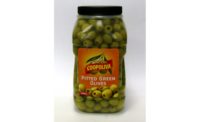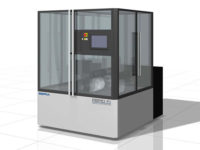MRI Flexible Packaging Co., headquartered in Newtown, Pa., was founded more than 30 years ago and is one of the leaders in the industry with state-of-the-art equipment for stretch sleeve, OPP roll fed, and shrink-sleeve labeling applications. The company leverages advanced flexographic presses, in-house graphic design, direct-to-plate digital prepress, inventory management, and internal and external technical support to provide outstanding speed-to-market production and service to its loyal customer base.
The label and packaging work MRI offers has evolved over the years. Customers demand the highest of quality, but are always looking to find ways to do more with less. In many cases, that is reflected in the new flexible packaging print work coming from gravure customers who are looking to switch to flexo. The biggest challenge in the past was delivering the high quality of gravure with the lower cost of flexo. To address that challenge, MRI has invested in new flexo solutions that deliver the savings, efficiency, and shelf impact that customer’s desire.
MRI first started exploring new flexo technologies when a particular client had a vignette issue in longer runs that just couldn’t be resolved with their current plates. Executives evaluated the options available in the market, visited other trade shops, and selected the Kodak Flexcel NX system after careful consideration. Primary factors that played into that decision were the solid ink density, higher line screens and plate longevity. Now, MRI runs the Kodak Flexcel NX plates exclusively for its label work and customers are very happy with the quality, cost, and consistency on their jobs.
Click here to see how MRI delivers packaging shelf Impact for clients using Kodak Flexcel NX System.
Jim Mallon, vice president of sales and marketing, and Will Vasquez, senior project manager, talk about MRI’s decision to adopt the Flexcel NX system and its impact on their business, trends in the flexo market and what they see as the next big label printing opportunity.
Q: What makes flexo such a good solution for MRI’s label production today?
Mallon: Today, advances in plates, inks and other components of a flexo solution are such that flexo can match or exceed the quality of gravure. An important driver behind our investment in the Flexcel NX system has been our customers’ increasing graphic complexity, combined with more SKUs (stock keeping units) than ever before. Significant prepress costs are associated with increasing SKU’s, revisions, and promotions for customers using gravure printing. The Flexcel NX system enables us to attain the 175-dpi and enriched color densities for flexography, and provides our customers with the inherent flexibility, quicker changeover and costs that are better aligned with the realities of the shrink sleeve label market.
Vasquez: We can handle adjustments much more efficiently by making flexo plates ourselves. This is also much cheaper and quicker than gravure. Gravure requires creating an entirely new engraved cylinder to accommodate new label designs. Many times, this process has to be outsourced. Reducing pre-press costs without sacrificing quality through flexo has really helped us grow our position in the shrink sleeve category.
Q: What changes have you seen in the label market over the last 30 years?
Mallon: A significant trend is the ever-increasing number of SKU’s required. Our flexo process combined with wide-web, state-of-the-art press technology allows us to meet this need without large prepress costs. Our ability to provide quick turnaround enables our customers to achieve the speed to market for new or extensions to existing products. With in-house graphic resources and the Flexcel NX system, we do not have to rely on outside plate sourcing to support our 24-hour operation.
Vasquez: It’s not just the greater number of SKU’s, but the increased complexity of the label artwork. Our customers are trying to find ways to differentiate their products in the retail environment. Customers want their labels to really “pop” on the shelf. Ten years ago, jobs weren’t as complex. Today, everyone is constantly raising the bar of the overall visual appeal of the label. With the Flexcel NX system, we are able to print label designs, which our customers want, with an expanded color gamut. In addition, we utilize specialty inks such as very chrome metallic, pearlescent, reflective coatings and matte varnishes.
Q: Tell us about some of the most common type of jobs you run.
Mallon: It is not unusual for us to run 20, 30 or 40 SKU’s in a 24-hour period. Managing this type of production schedule is our competitive edge and value proposition we offer to our customers. In this environment, the ability to create plates in-house as we need them is essential so that we rarely have down time. With the Flexcel NX system, it takes just one hour to make a new plate. And we’re able to store and reuse Flexcel NX plates for greater cost efficiency.
Q: What kinds of testing did you do before choosing your current plates?
Vasquez: Going through the plate evaluation process really helped us better understand and realize our customers’ expectations. We basically set up a comparison test between various plate manufacturers, including Kodak. The Flexcel NX plates’ strength and depth of color went above and beyond what we’d achieved previously. We ran a job, two-across, on press with the Flexcel NX plates on one side and a competitor’s plates on the other. The label contained images of strawberries. The side that printed with Flexcel NX plates was much more vibrant. It would have been easier not to switch but we owed it to ourselves and our customers to make the change. In 2013, we installed a Bobst 20SiX Press to run the Flexcel NX plates and that winning combination really took our label print quality to the next level.
Q: What impacts have the Flexcel NX plates had on your label production?
Vasquez: We’ve seen the greatest impacts in three areas: better solid ink density, higher line screen capability and longevity of the plates. Also, make-ready is much quicker. Once you put a plate in the system, make-ready is pretty much complete. We do quite a few press checks. In the past, that process took an entire shift to get colors and registration just right. Now, a customer is in and out within an hour because 99 times out of a 100 the customer is approving labels on the first pull.
Q: What changes do you see on the horizon for flexo?
Mallon: The big thing on the horizon for the flexo label market is expanded-gamut print technology. The expanded-gamut process uses CMYK and three other colors to create a color library match to PMS colors. This enables us to create the colors on press. The benefits of that are no trap lines and technically unlimited colors for customers with increased productivity on press, since we do not need to change out inks. Increased shelf impact, more complex graphics, increasing SKU’s, price pressure, innovative specialty inks and top coatings are becoming of increasing importance every day. MRI stands ready to deliver quality labels with the innovative solutions we use today and continued investments in the future!
Kodak
www.kodak.com/



